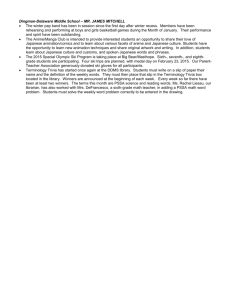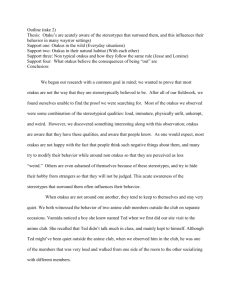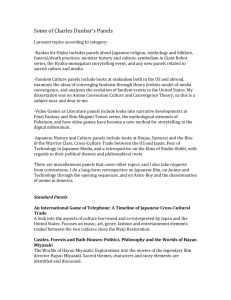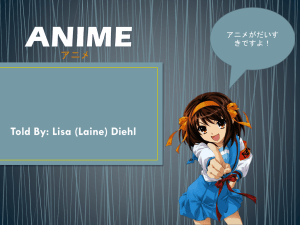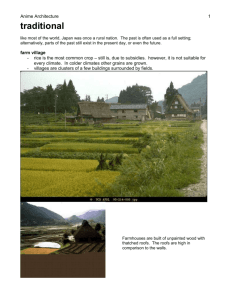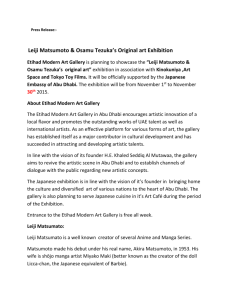Unit: Japanese Pop Culture: Anime
advertisement
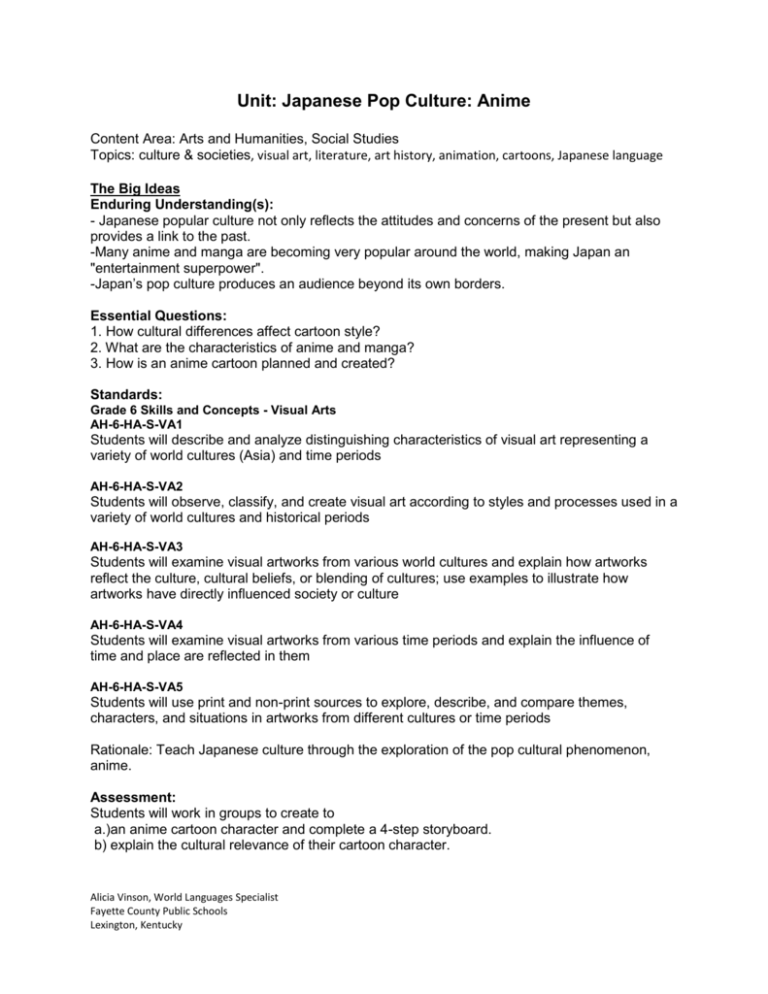
Unit: Japanese Pop Culture: Anime Content Area: Arts and Humanities, Social Studies Topics: culture & societies, visual art, literature, art history, animation, cartoons, Japanese language The Big Ideas Enduring Understanding(s): - Japanese popular culture not only reflects the attitudes and concerns of the present but also provides a link to the past. -Many anime and manga are becoming very popular around the world, making Japan an "entertainment superpower". -Japan’s pop culture produces an audience beyond its own borders. Essential Questions: 1. How cultural differences affect cartoon style? 2. What are the characteristics of anime and manga? 3. How is an anime cartoon planned and created? Standards: Grade 6 Skills and Concepts - Visual Arts AH-6-HA-S-VA1 Students will describe and analyze distinguishing characteristics of visual art representing a variety of world cultures (Asia) and time periods AH-6-HA-S-VA2 Students will observe, classify, and create visual art according to styles and processes used in a variety of world cultures and historical periods AH-6-HA-S-VA3 Students will examine visual artworks from various world cultures and explain how artworks reflect the culture, cultural beliefs, or blending of cultures; use examples to illustrate how artworks have directly influenced society or culture AH-6-HA-S-VA4 Students will examine visual artworks from various time periods and explain the influence of time and place are reflected in them AH-6-HA-S-VA5 Students will use print and non-print sources to explore, describe, and compare themes, characters, and situations in artworks from different cultures or time periods Rationale: Teach Japanese culture through the exploration of the pop cultural phenomenon, anime. Assessment: Students will work in groups to create to a.)an anime cartoon character and complete a 4-step storyboard. b) explain the cultural relevance of their cartoon character. Alicia Vinson, World Languages Specialist Fayette County Public Schools Lexington, Kentucky Background Information During our fellowship to Japan a lecture by Roland Kelts introduced us to the world of Anime. His book, Japanamerica: How Japanese Pop Culture Invaded the US, is an essential guide to the current state of anime production. Popular culture in Japan today appears in many instances -- especially for males between the ages of, say, twelve and thirty-four -- to revolve around anime (animated films, both theatrical releases and video productions) and manga (a type of visual literature including everything from comic strips to complex illustrated visual novels). Reflecting a traditional cultural orientation intensely visual in general, these commonplace forms of popular literature sell literally millions of copies monthly and are frequently found stacked in huge piles outside neighborhood bookstores. The most popular recent manga has been Akira, the complex tale (set in the year 2030) of a group of psychic Japanese victims of an atomic explosion that wiped out Tokyo years earlier. The story was published in monthly installments over a period of five years, winning an audience of millions of readers. Perhaps the most famous anime are those produced from the manga drawn by Hayao Miyazaki; they include such titles as Nausicaa: Valley of the Wind (a young princess whose powers provide her great empathy with the non-human life forms surrounding her), My Neighbor, Totoro (about a fantasy figure involved in the lives of two young children),Laputa (a castle in the sky...) and Kiki's Messenger Service. Be aware, however, that both the manga and the anime worlds lead off into some dark corners filled with explicit adult themes not suitable for all viewers; check out the Parent's Guide to Anime for some useful guidance. Procedure 1. Ask students to work with a partner to complete following chart to activate prior knowledge. K -represents what students already know about Japan and Anime W- represents what they would like to learn L- represents what they learned (note taking) Alicia Vinson, World Languages Specialist Fayette County Public Schools Lexington, Kentucky 2. Each student should have their own chart. Allow only 3-5 minutes to complete the chart and have the students change partners. Students will compare their charts with another partner. 3. With the whole group, discuss the charts. 4. Show the Anime PowerPoint (attached) 5. Follow the PowerPoint with a discussion. 6. Give the students the Anime handout and explain the task. Tell the students to go to the Wikipedia website, http://en.wikipedia.org/wiki/Anime and research the following terms: Anime, manga, uyiko-e, Akira, AMV, catgirl, chibi, cosplay, dojinshi or doujinshi, fanfic, ,J-pop, otaku, ona, seiyu. 7. Ask students to complete a Venn diagram to compare and contrast the work of Disney and Tezuka. Materials: Art Supplies Ven Diagram Anime PowerPoint Vocabulary Worksheet Teacher Resources: http://www.dnp.co.jp/museum/nmp/nmp_i/articles/manga/manga2.html www.abcb.com/parents: The Anime Cafe's "A Parent's Guide to Anime" has a more complete listing of G, PG and PG-13, and R-rated anime shows and movies. en.wikipedia.org/wiki/Anime: A comprehensive article about anime. www.koyagi.com/Libguide.html: The Librarian's Guide to Anime and Manga Animagess. “Part 1: Style.” How To Draw Anime Style Art by Animagess. http://animeworld.com/howtodraw/animagess/1-style.html Animagess. “Part 2a: Faces - Styles and Design Examples.” How To Draw Anime Style Art by Animagess. http://animeworld.com/howtodraw/animagess/2a-faces.html Animagess. “Lesson 1: Faces.” How To Draw Anime Style Art by Animagess. http://animeworld.com/howtodraw/faces.html Animagess. “Part 2b: Faces - The Structure.” How To Draw Anime Style Art by Animagess. http://animeworld.com/howtodraw/animagess/2b-faces.html Alicia Vinson, World Languages Specialist Fayette County Public Schools Lexington, Kentucky Image of Superman, DC Comics , http://www.tribuneindia.com/2001/20010826/spectrum/2tv.jpg Compared to an Anime image of Goku™, http://www.talsorian.com/images/dbzcover.jpg History of Anime http://www.awn.com/mag/issue1.5/articles/patten1.5.html ** It will take several class periods to complete this unit Alicia Vinson, World Languages Specialist Fayette County Public Schools Lexington, Kentucky
